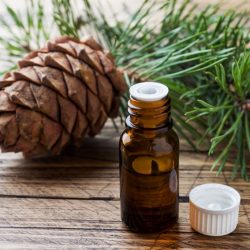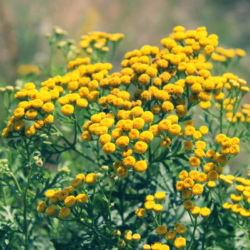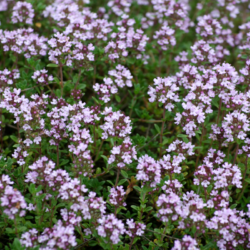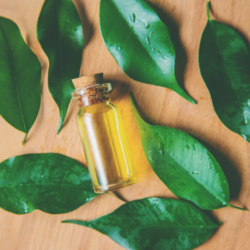Born somewhere between Istanbul and Odessa, dill is mentioned in an Egyptian medical treatise dating back over 5,000 years. For a long time, dill oil was confined to a limited geographical area and did not immediately spread across Europe. Yet the Romans, seduced by its aniseed scent and seeing it as a symbol of vitality, made it part of their daily routine. From gladiators feasting on dill-flavoured dishes to the refined recipes of Apicius, this aromatic herb slowly but surely conquered the palates and hearts of Northern Europeans. But what is this plant that has spanned the ages and cultures, and what are the characteristics that make its essential oil so highly prized today?
What are the characteristics of Dill?
Dill, scientifically known asAnethum graveolens, belongs to the Apiaceae family. This herbaceous plant is grown mainly for its highly aromatic leaves and seeds. The smell and properties of dill are vaguely reminiscent of fennel, hence its nicknames ” bastard fennel ” or ” false anise “.
In descriptive terms, dill is an annual plant growing to between 50 and 120 cm tall, with a spread of around 30 cm. Its leaves are characteristically thin, wiry and bluish-green in colour. When in flower, dill produces umbels with 15 to 30 rays of greenish-yellow flowers. Dill fruits are small, oval, flattened, brown and split into two seeds when dried. They generally ripen in August-September.
The name ” dill ” derives from the Latin anethum, itself borrowed from the Greek ἄνηθον – anêthon. The Latin word graveolens means “strong smelling”. Its synonyms include Anethum sowa Roxburgh and Peucedanum graveolens. In French, it is also known as aneth odorant, fenouil puant or faux anis.
In terms of chemical composition, dill fruits contain an essential oil rich in carvone, myristicin and apiol, as well as tannins and mucilage.
Botanically, dill is a herbaceous plant, sometimes biennial, with erect, smooth stems. Dill has petiolate basal leaves and umbellate inflorescences without bracts or bracteoles. Its fruits are ellipsoidal or ovo-ellipsoidal in shape and flatten sharply at the back.
This plant grows mainly in Mediterranean regions, and is cultivated or appears subspontaneously in southern Europe, western Asia and northern Africa. Known for its carminative and diuretic properties, dill is often used to flavour laundry.
What does it contain?
Dill essential oil, with its specific biochemical components, is a favourite choice for aromatherapy. Its composition includes between 25 and 55% limonene and 20 to 50% carvone, with low concentrations of trans dihydrocarvone and cis dihydrocarvone.
This essential oil, derived from the plant Anethum graveolens in the Apiaceae family, can be distinguished by its various common names, such as Dill, Sweet Dill, False Anise and Bastard Fennel. It is mainly extracted from flowering plants and comes from regions such as France, Bulgaria, Holland, Poland and Romania.
In terms of its biochemical composition, dill essential oil consists mainly of monoterpenes (60 to 65%) and ketones (28 to 30%), including limonene, alpha and beta phellandrene and paracymene. It also contains monoterpene oxides, monoterpenols and coumarins.
The physical characteristics of this oil are also important: it has a specific gravity of 0.890 to 0.915 at 20°C, a refractive index of 1.483 to 1.490 at 20°C, a rotatory power of 70° to 82° at 20°C, and a flash point at 60°C. Organoleptically, it appears as a colourless to slightly yellow oil with a sweet, minty, fresh odour.
In terms of indications, dill essential oil is effective for a variety of health and well-being applications. It helps relieve bloating, flatulence and digestive problems thanks to its eupeptic, antispasmodic, stomachic and carminative properties. It is also beneficial for treating aerophagia and digestive problems in infants, thanks to its galactagogue effect. It is also useful in cases of liver failure, kidney pain and nausea. In terms of well-being, it is recommended for combating seasonal depression, intellectual fatigue, mental tension and improving concentration.
What are the pharmacological properties of Dill fruiting aerial parts essential oil?
The antispasmodic effect of dill essential oil has been demonstrated with carvone on smooth muscles in relation to acetylcholine and histamine;α-phellandrene reduces intestinal contractions through interaction with 5-hydroxytriptamine 3 receptors. A digestivestimulant and antispasmodic, it increases basal tone and contractions of the intestinal smooth muscle, and has a carminative effect. This plant is also antitoxic, diuretic, urinary tract antispasmodic and renal antispasmodic.
Detoxifying and hepatoprotective, carvone ‘sdetoxifying action on the liver is linked to stimulation of cytochromes P-450 or phase II enzymes such as gluthation-S-transferase. The limonene and carvone present in Dill essential oil stimulate bile secretion, showing a choleretic and cholagogue effect. As a fluidifier in cases of hepatobiliary and pancreatic insufficiency, Dill increases the secretion of gastric juices.
Carvone also lowers cholesterol levels and triglyceride accumulation in the liver. Carminative, cholagogue and choleretic thanks to the ketones which remove stases and restore movement in general, Dill is therefore useful in cases of bloating, meteorism or colopathy. Limonene and carvone stimulate bile secretion.
Digestive, carvone reduces nausea by acting on gastric motility and gastric acidity during gastro-oesophageal reflux. Limonene stimulates digestive microcirculation.
Bronchial fluidifier, mucolytic and antifungal, the latter action is linked toα-phellandrene and limonene . Dill is also cortison-like, stimulating the pituitary-cortical-adrenal axis, making it useful in inflammatory conditions.
It is also thought to have antimicrobial, antidepressant and lipid-lowering properties through activation of the PPAR-α (proliferator-activated receptor-α) peroxisome, as well as being a general tonic and stimulant, thanks to the monoterpenes, which become positivising because they ionise positively and very easily. It also inhibits acetylcholinesterase and butyrylcholinesterase.
How should this essential oil be used?
What dosage should I choose?
Dill essential oil is used in a variety of ways depending on its properties and specific needs.
Forcutaneous application and massage, it is essential to dilute dill essential oil 20% in a vegetable oil to avoid skin irritation. This preparation can be massaged into targeted areas such as theabdomen, liver, back or kidneys. In special cases:
- For bronchitis, we recommend massaging the back and soles of the feet with the diluted oil.
- Forotitis, apply a drop behind each ear, without penetrating the ear.
- For a hacking cough, massage the back with the diluted oil.
- For nausea, a trace of oil can be applied to the mouth.
- For kidney pains, massage the kidney area after dilution and prior medical consultation.
- Forliver failure, massage the liver area with diluted oil.
- For digestive problems, massage the abdomen with diluted oil.
Dill essential oil can be taken orally, especially to aid digestion, but always under the supervision of a specialist to avoid the risk of nephrotoxicity.
Dill essential oil can be diffused in a number of ways:
- Diffusion by nebulisation is very effective, although expensive and sometimes noisy.
- Ultrasonic diffusion (fogging) is less powerful but suitable for enclosed spaces.
- Diffusion by gentle heat requires you to pour a few drops of oil into the diffuser’s receptacle, and is ideal for small, enclosed rooms.
In short, dill essential oil offers a variety of applications, for both health and well-being, with particular attention to the method of use and the correct dilution.
Does Dill essential oil require any precautions for use?
The history of this medicinal plant
Dill, which probably originated in the Near East, first spread to the Caucasus and Egypt. The ancient Egyptians documented it in the Ebers papyrus (1500 BC). The Leyden magic papyrus, written in Greek, calls it the ” seed of Hermes “. Figures such as Hippocrates, Dioscorides and Galen wrote about dill, proving that it arrived in Europe long before our era.
The ancient Greeks used dill, combined with fennel and verbena root, to combat female sterility. Pliny and Virgil in ancient Rome also mentioned dill. In the Middle Ages, the Salerno school and Saint Hildegard used it as a remedy. The Salerno school praised dill for “driving away winds and reducing humours”. St Hildegard recommended it for nosebleeds and other ailments.
Matthiole notes that dill was ubiquitous in the gardens of his time, being one of the ingredients of theriacs. Its seeds, along with chamomile, sweet clover and matricaria, formed the quartet of carminative plants used by apothecaries. Although dill was long restricted to southern Europe, it eventually conquered northern regions. Appreciated by the Romans for its aniseed-like scent, it was present in the recipes ofApicius and the food of gladiators.
In the Middle Ages, a sprig of dill was used as a talisman against witchcraft. Mentioned in Sanskrit texts and the New Testament, dill has long been known in Palestine. Theessential oil of dill belongs to the four carminative seeds and has been used since the 15th century. Dioscorides recommended dill to stimulate the milk of nursing mothers, while Avicenna emphasised its properties in expelling winds.
In the 12th century, Saint Hildegard prescribed it for nosebleeds, and in the 19th century, Cazin compared it to fennel for its digestive benefits. Fournier, in the 20th century, mentions its use against hiccups.
Medical bibliographic sources and clinical trials
- Takahashi N, Yao L, Kim M, Sasako H, Aoyagi M, Shono J, Tsuge N, Goto T, Kawada T. Dill seed extract improves abnormalities in lipid metabolism through peroxisome proliferator-activated receptor-α (PPAR-α) activation in diabetic obese mice. Mol Nutr Food Res. 2013
- Yasdanparast R, Alavi M. Antihyperlipidaemic and anti-hypercholesterolaemic effects of Anethum graveolens leaves after the removal of furocoumarins. Cytobios. 2001
- Kazemi M. Phenolic profile, antioxidant capacity and anti-inflammatory activity of Anethum graveolens L. essential oil. Nat Prod Res. 2014
- Orhan I, Kartal M, Kan Y, Sener B. Activity of essential oils and individual components against acetyl- and butyrylcholinesterase. Z Naturforsch C. 2008
- Franchomme P., Jollois R., Penoël D., L’Aromathérapie exactement, ed. Roger Jollois, 2001
- Fleurentin J., Du bon usage de l’aromathérapie, Ouest-France, 2018







